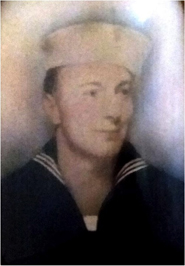Our Neighbors in the Service
Oto, Iowa—Private Max B. Brown, son of Mrs. T.J. Leesley of Oto, is stationed with the Canadian armed forces at Manitoba. His brother, Wesley J. Brown, was killed in action December 7 at Pearl Harbor for which his mother was awarded the Purple Heart.
Source: The Sioux City Journal, August 29, 1943
![]()
Wesley James Brown was born Mar. 11, 1916 to R. J. and Bessie White Brown. He died Dec. 7, 1941 and is memorialized at the Courts of the Missing, Court 5, Honolulu Memorial and at the USS Oklahoma Memorial, Honolulu, Hawaii.
Petty Officer Brown served in World War II with the U.S. Navy and was MIA/KIA aboard the USS Oklahoma (BB-37) when it was attacked and sunk at Pearl Harbor, Hawaii. He was awarded the Purple Heart.
Source: ancestry.com; abmc.gov
![]()
Remains of Oto sailor who died in Japanese attack on USS Oklahoma identified
SMITHLAND, Iowa -- Gaylyn Beckner never knew her Uncle Wesley Brown, never was told much about him.
What he was like as a young man, his personality, those details weren't discussed very often. Buckner's mother, Ida Bainbridge, said little about her older brother in their Smithland home.
"I really didn't know anything. My mother didn't really talk about it. It hurt her too much," said Beckner, born in 1945, well after U.S. Navy Fireman 1st Class Wesley J. Brown, of Oto, age 25, was killed on board the battleship USS Oklahoma during the Dec. 7, 1941, Japanese attack on Pearl Harbor.
In the Canadian province of Saskatchewan, members of another branch of Brown's family tree also felt his loss. Like Beckner, Marilyn Cugnet didn't hear her mother, Fern Knibbs, speak much of her brother's death, which was multiplied later in World War II when a second brother, Max, a Canadian soldier, was killed in Germany.
"Mom talked about it, but I think it hurt them so much," Cugnet, of Weyburn, Saskatchewan, said.
Considering the pain Wesley Brown's sisters carried with them after his death, it made sense that both Beckner and Cugnet thought of their mothers when the family was notified in late January that Brown's remains had been identified and would be returned to the family for burial.
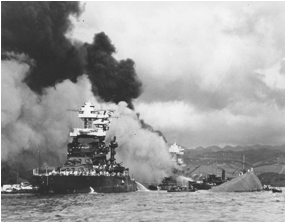
In this Dec. 7, 1941, file photo, part of the hull of the capsized USS Oklahoma is seen at right as the battleship USS West Virginia, center, begins to sink after suffering heavy damage, while the USS Maryland, left, is still afloat in Pearl Harbor. Wesley James Brown, 25, of Oto, Iowa, was one of 429 crewmen of the USS Oklahoma who were killed. He was buried as an unknown for years until his remains were disinterred in 2015 and recently identified.
Associated Press
"I was in shock. I guess I couldn't think it was possible," Beckner said. "I wish it would have happened when my mother was alive. It would have meant a lot to her."
Bainbridge, her mother, died Nov. 29, 2006, at age 80. Cugnet's mother, who was five years older than Brown, died in 1988.
"I was happy. I was sad. It's been so many years," Cugnet said. "I thought of my mom and my grandma."
Upon a request from the Navy Casualty Assistance Office, Beckner and another relative had submitted cheek swabs to provide DNA samples they hoped could be matched with one of the dozens of sets of remains of unknown crewmen who were disinterred in 2015 as part of the USS Oklahoma Project.
Brown was among the 429 crewmen killed in the attack, in which the battleship took multiple hits from Japanese torpedoes and capsized quickly, trapping dozens of men below deck. In the days after the attack, victims whose identities were both known and unknown were buried in Honolulu. Remains recovered in 1943 after the ship was righted were buried in mass graves in Honolulu's National Memorial Cemetery of the Pacific, also known as the Punchbowl.
As of 2003, a total of 394 crewmen were unaccounted for and buried as unknowns. From 2007-10, seven of them were disinterred and identified, leading to the ambitious effort to disinter all remaining unknowns buried in 62 graves in hopes they all could be identified.
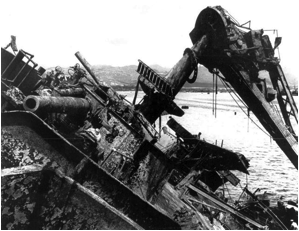
In this May 24, 1943, file photo, the capsized battleship USS Oklahoma is lifted out of the water at Pearl Harbor. Dozens of crewmen who were trapped inside the ship and died after the Dec. 7, 1941, attack at Pearl Harbor were removed from the ship and buried as unknowns. The remains of Wesley James Brown, of Oto, Iowa, were recently identified and will be returned to his family for burial.
Associated Press
Some 13,000 bones were sent to the Defense POW/MIA Accounting Agency lab at Offutt Air Force base in Omaha, where a team of anthropologists has been reassembling them into sets of remains.
DNA samples obtained from the bones are sent to the Armed Forces Medical Examiner System's DNA Laboratory in Dover, Delaware, for testing and comparison with DNA samples collected from relatives. Once a match is made, results are returned to the DPAA lab at Offutt for final identification. The process can take as little as a couple months, or it can take years.
"We're going to ID as many as we can," said Carrie LeGarde, an anthropologist and USS Oklahoma Project lead at the Offutt lab.
Since 2003, 302 sets of remains have been identified, leaving 92 crewmen still unaccounted for. Of those, only 14 do not have family DNA reference samples on file, LeGarde said, so chances are good that several more unknowns will be identified.
Brown's case was more complex than many others. Unable to divulge a lot of the details, LeGarde said a second step of DNA testing was required, a necessity sometimes to segregate remains that have been in the same grave. Using DNA from Brown's relatives and other information that for now can't be released, anthropologists were able to make an identification on Dec. 22, an achievement that, like all the others, was celebrated.
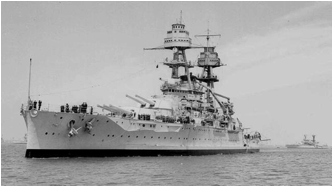
The battleship USS Oklahoma is shown in this April 1938 file photo. The ship capsized during the Dec. 7, 1941, Japanese attack on Pearl Harbor and 429 crewmen were killed, many of them buried without their identities known. All unknown crew members have been disinterred and, using DNA technology, identified. The remains of Wesley James Brown, of Oto, Iowa, were recently identified and will be returned to the family for burial.
Associated Press
"It's really exciting to make any of these IDs. Each one of these is important," LeGarde said. "When these IDs are made, you stop and reflect on the importance of it and the meaningfulness. It's just really rewarding."
Cugnet said her family feels at peace knowing Brown, whose roots run from Canada to Iowa, has been identified.
He was born March 1, 1916, in Eureka, Montana, to Randolph and Bessie White Brown, who was originally from Washta, Iowa. They moved later that year to a farm in Saskatchewan, where Bessie remained until 1937, when, after her marriage to Randolph had broken up, she returned to Iowa, moving to a farm near Oto with Wesley and his sister Ida. Bessie Brown later married Tom Leesley. Bessie Leesley died Feb. 1, 1973, at age 84 and is buried in Smithland.
Cugnet was born in 1940 but never met her uncle, who enlisted in the Navy on Aug. 22, 1939. She's gained some insight into his personality through letters he sent the family while in the Navy. Those notes, each signed "Sailor Wes," have become treasured pieces of family history.
"He wrote the most beautiful letters," Cugnet said. "When we read those letters, he was sort of comical, and I think he really enjoyed being in the Navy."
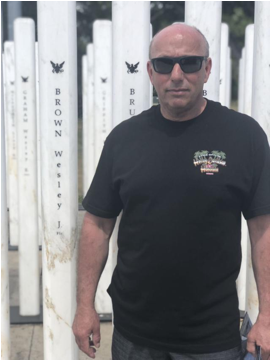
Wesley Cugnet, of Weyburn, Saskatchewan, Canada, a great-nephew of Wesley James Brown, stands next to Brown's name at the USS Oklahoma Memorial at Pearl Harbor. Brown, 25, of Oto, Iowa, was killed in the Dec. 7, 1941, attack and his remains were recently identified.
Provided by Lisa Cugnet
After Brown's death, the Navy sent the family a portrait of him, an heirloom that passed to sister Ida Bainbridge, and now to Beckner. In it, he's pictured as a smiling young man in his blue Navy uniform.
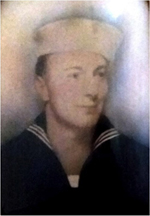
A young man who will be returned to Smithland to be buried near his mother and sister. The family had considered a burial at Omaha National Cemetery, but decided he belonged at home. "We thought he would rather be with his family, his mother," Beckner said.
A burial date has not yet been scheduled, she said, and the family has yet to meet with the Navy to finalize arrangements. Many details remain, Beckner said, for a task she never really expected to undertake.
"My mind's still kind of whirling," she said two weeks after receiving the call that Brown's remains had been identified. "It's starting to settle in."
Source: The Sioux City Journal, February 21, 2021 - Written by Nick Hytrek
![]()
PRESS RELEASE | June 11, 2021
USS Oklahoma Sailor Accounted For From World War II (Brown, W.)
WASHINGTON – The Defense POW/MIA Accounting Agency (DPAA) announced today that Navy Fireman 1st Class Wesley J. Brown, 25, of Helena, Montana, killed during World War II, was accounted for on Dec. 22, 2020.
On Dec. 7, 1941, Brown was assigned to the battleship USS Oklahoma, which was moored at Ford Island, Pearl Harbor, when the ship was attacked by Japanese aircraft. The USS Oklahoma sustained multiple torpedo hits, which caused it to quickly capsize. The attack on the ship resulted in the deaths of 429 crewmen, including Brown.
From December 1941 to June 1944, Navy personnel recovered the remains of the deceased crew, which were subsequently interred in the Halawa and Nu’uanu Cemeteries.
In September 1947, tasked with recovering and identifying fallen U.S. personnel in the Pacific Theater, members of the American Graves Registration Service (AGRS) disinterred the remains of U.S. casualties from the two cemeteries and transferred them to the Central Identification Laboratory at Schofield Barracks. The laboratory staff was only able to confirm the identifications of 35 men from the USS Oklahoma at that time. The AGRS subsequently buried the unidentified remains in 46 plots at the National Memorial Cemetery of the Pacific (NMCP), known as the Punchbowl, in Honolulu. In October 1949, a military board classified those who could not be identified as non-recoverable, including Brown.
Between June and November 2015, DPAA personnel exhumed the USS Oklahoma Unknowns from the Punchbowl for analysis.
To identify Brown’s remains, scientists from DPAA used dental and anthropological analysis. Additionally, scientists from the Armed Forces Medical Examiner System used mitochondrial DNA (mtDNA) and Y chromosome (Y-STR) analysis.
Brown’s name is recorded on the Courts of the Missing at the Punchbowl, along with the others who are missing from WWII. A rosette will be placed next to his name to indicate he has been accounted for.
Brown will be buried on Aug. 28, 2021, in Smithland, Iowa.
![]()
Remains of Oto sailor killed in Pearl Harbor attack returned home
- Photos contributed by volunteer, C. Swearingen of Iowa.
- Aug 28, 2021
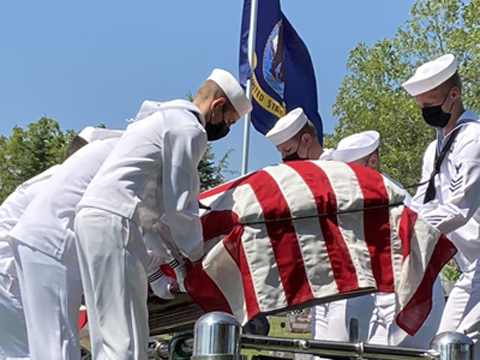
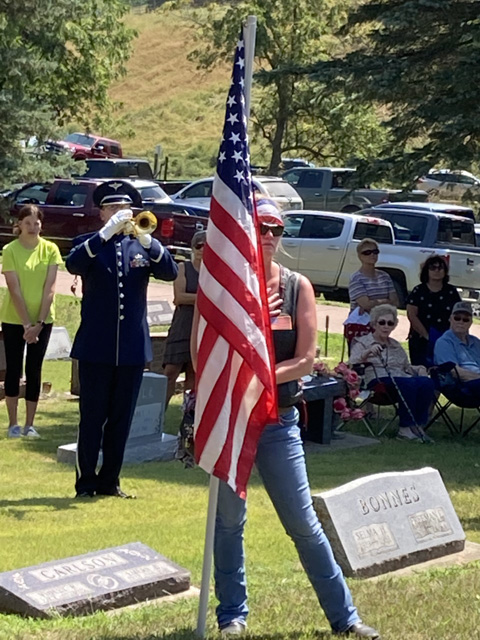
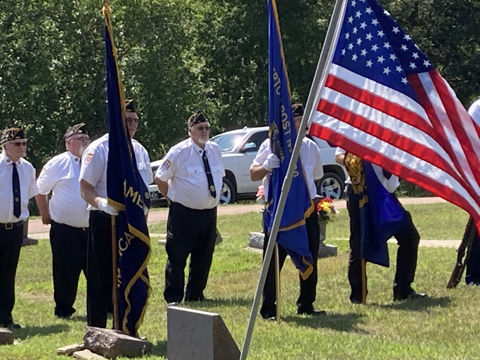
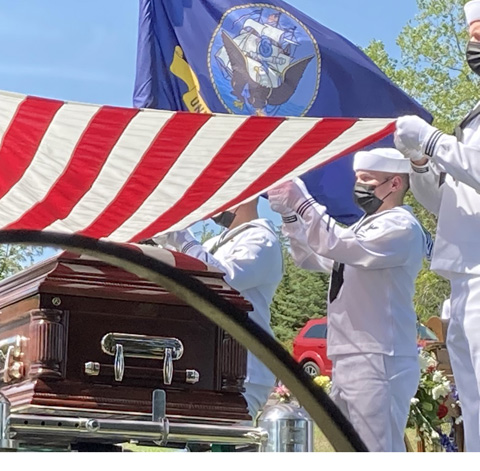
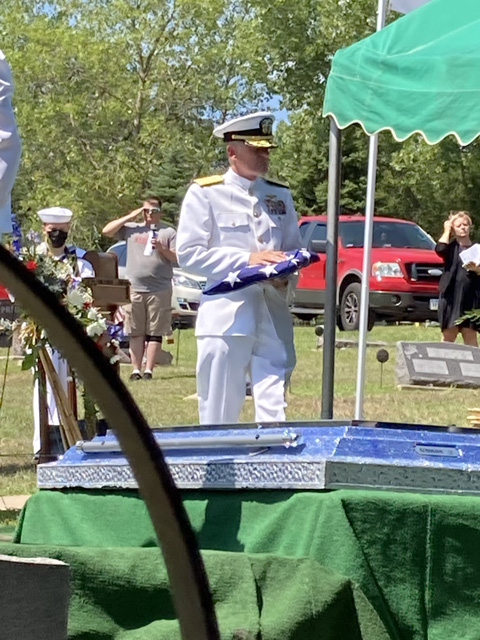
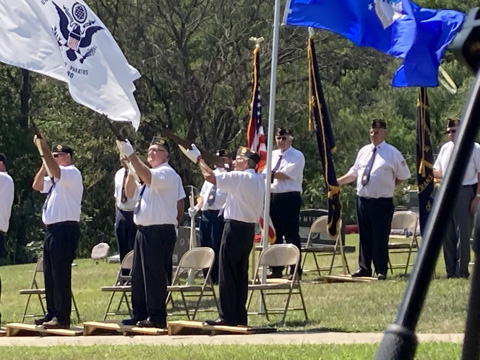
![]()
